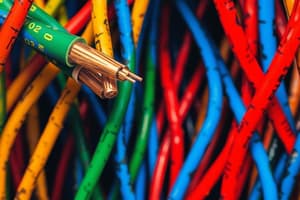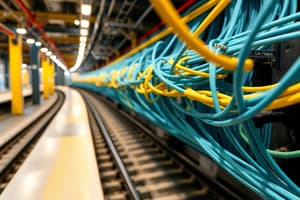Podcast
Questions and Answers
What is required to ensure the proper functionality of earth electrodes?
What is required to ensure the proper functionality of earth electrodes?
- Install additional earth electrodes for redundancy
- Verify the connectivity of ground wires to each equipment (correct)
- Measure the voltage output of each equipment
- Conduct software testing prior to hardware testing
Which document is NOT part of the required documentation for indoor equipment?
Which document is NOT part of the required documentation for indoor equipment?
- Installation manual for equipment
- Subscriber wise Telephone Directory (correct)
- Wiring diagram for power panel
- Operation and maintenance manual
Which tool is essential for crimping connections in cabling?
Which tool is essential for crimping connections in cabling?
- Cable Fault Locator
- Krone Extractor
- Crimping tool (correct)
- Screw driver
What type of measuring instrument is required to test line conditions?
What type of measuring instrument is required to test line conditions?
What type of documentation provides the layout and connection details for each rack?
What type of documentation provides the layout and connection details for each rack?
Which types of phones are connected through the exchange?
Which types of phones are connected through the exchange?
What type of signaling is NOT mentioned as used in the exchange?
What type of signaling is NOT mentioned as used in the exchange?
What is the capacity of the railway telephone number system?
What is the capacity of the railway telephone number system?
Which of the following statements is true regarding the architecture of the exchange?
Which of the following statements is true regarding the architecture of the exchange?
What is the primary benefit of the non-blocking type TDM exchange?
What is the primary benefit of the non-blocking type TDM exchange?
In the boss-secretary configuration, what happens if the secretary's phone is unanswered?
In the boss-secretary configuration, what happens if the secretary's phone is unanswered?
How many ports have been provided for high-speed connectivity between exchanges?
How many ports have been provided for high-speed connectivity between exchanges?
What feature is available in divisional/zonal IP exchanges?
What feature is available in divisional/zonal IP exchanges?
Where should the Main Distribution Frame be installed?
Where should the Main Distribution Frame be installed?
What is the preferred material for the earth connection along the frame?
What is the preferred material for the earth connection along the frame?
What temperature range should be maintained in the exchange equipment room?
What temperature range should be maintained in the exchange equipment room?
What should be done with underground ducts for cable entry?
What should be done with underground ducts for cable entry?
What is the primary language for the man machine communication (MML)?
What is the primary language for the man machine communication (MML)?
What should not happen when executing any command in the system?
What should not happen when executing any command in the system?
What should be ensured when commands contain errors?
What should be ensured when commands contain errors?
Why is continuous testing of the system important?
Why is continuous testing of the system important?
What is a requirement for railway exchange subscribers to join a video conference meeting?
What is a requirement for railway exchange subscribers to join a video conference meeting?
Which component is NOT part of the exchange system?
Which component is NOT part of the exchange system?
What type of power supply is required for IP exchanges?
What type of power supply is required for IP exchanges?
What should be available to ensure interaction with the Exchange?
What should be available to ensure interaction with the Exchange?
What feature must the IDF include for effective safety?
What feature must the IDF include for effective safety?
What type of charger must be provided for a -48V DC power supply?
What type of charger must be provided for a -48V DC power supply?
How should outdoor cables be managed within the exchange system?
How should outdoor cables be managed within the exchange system?
What must be ensured for the IDF to function effectively?
What must be ensured for the IDF to function effectively?
What is the maximum traffic calculated for trunk lines in the railway exchange?
What is the maximum traffic calculated for trunk lines in the railway exchange?
What is NOT a requirement for the All India Intercom for railway officers?
What is NOT a requirement for the All India Intercom for railway officers?
Which configuration is recommended for redundancy in IP exchange servers?
Which configuration is recommended for redundancy in IP exchange servers?
What must be ensured in a closed numbering scheme for railway divisions?
What must be ensured in a closed numbering scheme for railway divisions?
What type of server should the IP exchange be installed on?
What type of server should the IP exchange be installed on?
What is the preferred method of securing the network?
What is the preferred method of securing the network?
What is the purpose of logging important events in the IP exchange?
What is the purpose of logging important events in the IP exchange?
What facility should be provided for interconnection to the PSTN exchange?
What facility should be provided for interconnection to the PSTN exchange?
What is required of the protective device in terms of voltage rating?
What is required of the protective device in terms of voltage rating?
What kind of fault detection capability is required from the system?
What kind of fault detection capability is required from the system?
What is the primary purpose of the protective devices in the IDF?
What is the primary purpose of the protective devices in the IDF?
Which of the following is a requirement for the current/voltage rating of the protective device?
Which of the following is a requirement for the current/voltage rating of the protective device?
What type of maintenance is required on a daily basis?
What type of maintenance is required on a daily basis?
What is the benefit of having self-restoring protective devices?
What is the benefit of having self-restoring protective devices?
What must be avoided in the operation of protective devices?
What must be avoided in the operation of protective devices?
How often should individual cell voltage and load tests be performed on batteries?
How often should individual cell voltage and load tests be performed on batteries?
Flashcards
SIP/PRI/E1 Connectivity
SIP/PRI/E1 Connectivity
A method of connecting telephone networks, often between zonal and divisional exchanges or to PSTN.
Closed Numbering Scheme
Closed Numbering Scheme
A uniform 5-digit number system for railway divisions across zonal networks.
DID/DOD Facility
DID/DOD Facility
Direct Inward/Outward Dialing for connecting to PSTN exchanges.
All India Intercom (IP Phone)
All India Intercom (IP Phone)
Signup and view all the flashcards
Redundant Power Supply (IP Exchange)
Redundant Power Supply (IP Exchange)
Signup and view all the flashcards
Generic Hardware Platform
Generic Hardware Platform
Signup and view all the flashcards
Trunk Line Traffic
Trunk Line Traffic
Signup and view all the flashcards
End-to-End Security
End-to-End Security
Signup and view all the flashcards
Exchange Ports
Exchange Ports
Signup and view all the flashcards
High-Speed Trunk Ports
High-Speed Trunk Ports
Signup and view all the flashcards
Exchange Capacity
Exchange Capacity
Signup and view all the flashcards
TDM Exchange
TDM Exchange
Signup and view all the flashcards
User Line Signaling
User Line Signaling
Signup and view all the flashcards
Inter-Exchange Signaling
Inter-Exchange Signaling
Signup and view all the flashcards
Railway Telephone Number
Railway Telephone Number
Signup and view all the flashcards
Audio Conferencing
Audio Conferencing
Signup and view all the flashcards
Earth Electrode Resistance
Earth Electrode Resistance
Signup and view all the flashcards
Hardware Testing
Hardware Testing
Signup and view all the flashcards
Software Testing
Software Testing
Signup and view all the flashcards
Exchange Layout Plan
Exchange Layout Plan
Signup and view all the flashcards
Subscriber's Details
Subscriber's Details
Signup and view all the flashcards
Main Distribution Frame
Main Distribution Frame
Signup and view all the flashcards
Earth Connection
Earth Connection
Signup and view all the flashcards
Lightning and Surge Protection
Lightning and Surge Protection
Signup and view all the flashcards
Earth Distribution Frame
Earth Distribution Frame
Signup and view all the flashcards
Exchange Equipment Room Air Conditioning
Exchange Equipment Room Air Conditioning
Signup and view all the flashcards
Equipment Rack Placement
Equipment Rack Placement
Signup and view all the flashcards
Man Machine Language (MML)
Man Machine Language (MML)
Signup and view all the flashcards
System Supervision
System Supervision
Signup and view all the flashcards
Video Conferencing Integration
Video Conferencing Integration
Signup and view all the flashcards
FXS/FXO/PRI Gateway
FXS/FXO/PRI Gateway
Signup and view all the flashcards
Man Machine Interaction
Man Machine Interaction
Signup and view all the flashcards
Power Supply Redundancy
Power Supply Redundancy
Signup and view all the flashcards
Intermediate Distribution Frame (IDF)
Intermediate Distribution Frame (IDF)
Signup and view all the flashcards
Main Distribution Frame (MDF)
Main Distribution Frame (MDF)
Signup and view all the flashcards
Subscriber Telephone Sets
Subscriber Telephone Sets
Signup and view all the flashcards
Maintenance Tools
Maintenance Tools
Signup and view all the flashcards
Fault detection
Fault detection
Signup and view all the flashcards
System redundancy
System redundancy
Signup and view all the flashcards
Protective device purpose
Protective device purpose
Signup and view all the flashcards
Protective device requirements
Protective device requirements
Signup and view all the flashcards
Fuse and lightning discharger
Fuse and lightning discharger
Signup and view all the flashcards
Preventive maintenance
Preventive maintenance
Signup and view all the flashcards
Battery set voltage
Battery set voltage
Signup and view all the flashcards
Failure history list
Failure history list
Signup and view all the flashcards
Study Notes
Railway Exchanges
- Railway exchanges use automatic, electronic, and digital technologies, including IP technology. New exchanges must use IP technology.
- Session Initiation Protocol (SIP) is used for IP telephony. Exchange software runs on standard servers.
- Open-source VoIP software is typically used for integration and cost-effectiveness.
- IP exchanges used in railway telecommunications must adhere to open standards to ensure interoperability. They should support third-party phones and include licensing if necessary.
- Video telephony is supported by the system.
- IP telephony integrates with existing LAN infrastructure, using a separate voice VLAN for prioritized voice traffic over general data.
Intercom Systems
- Intercom facilities can be independent exchanges or use features of main exchanges. Optimizing intercom systems is a goal.
Gateways
- FXS gateways interface with FAX machines, analog phones, and other analog telephony equipment, either centralized or distributed.
- IP phones use PoE (Power over Ethernet) for power and have two Gigabit Ethernet ports. This provides direct LAN connectivity to the PC and eliminates the need for a separate LAN connection in each room.
Connectivity
- SIP trunks/PRI (Primary Rate Interface) gateways connect to NGN (Next Generation Network) or PSTN (Public Switched Telephone Network). FXO (Front Exchange Office) devices are used if PSTN PRI connectivity is unavailable.
- VoIP phones used in exchanges must meet open standards. These phones will work with third-party exchanges and SIP servers.
###Telephone Sets
- Subscriber telephone sets can be analog or IP (including softphones and video phones); IP phones should support SIP.
- Analog phones should have CLI (Command Line Interface) functionality
Divisional and HQ Exchanges
- Divisional and headquarters exchanges connect to NGN using either PRI(Primary Rate Interface) or SIP trunks. Subdivisional exchanges can also connect to NGN if feasible. Multiple paths and media gateways in the NGN network improve reliability.
- Sub-divisional exchanges connect to divisional exchanges using PRI or SIP Trunks in a mesh or ring configuration. Divisional IP exchanges can be used where possible.
- NGN networks handle STD (subscriber trunk dialing) calls. Each headquarters and divisional exchange gets a unique railway STD code.
Numbering Scheme
- Railways establish a closed numbering scheme of 5 digits, making exchanges nationally accessible via their designated division STD codes.
Intercom, Maintenance and System Requirements
- A Railway-wide intercom is available for senior officers.
- An IP exchange server, with redundant power supplies, offers active-active or active-passive redundancy.
- Remote maintenance centers support remote management of the exchange.
- The system can function as a local, tandem, transit, or combined exchange.
- The system supports video telephony.
- Railway telephone numbers are five digits plus an allocated STD code (Three digits including the leading zero).
Protective Devices
- Surge protection devices (on IDF, Intermediate Distribution Frames) prevent damage from excess voltage or current. Their voltage rating is slightly above the exchange's voltage levels. These devices should isolate the equipment. The devices must be self-restoring type
- Protection arrangement on IDF and MDF (Main Distribution Frame) are required to ensure that the service is not affected.
Maintenance Procedures
- Daily, monthly, quarterly, and six-monthly routine maintenance tasks include testing of batteries, cables, and other components.
- Yearly, comprehensive wiring and insulation checks are recommended.
- Detailed documentation is required to assist in service and maintenance.
Exchange Components and Cabling
- The system consists of hardware (e.g., racks, cables, and termination boxes), software, gateways and cables, and a power supply.
- The system integrates test and measuring equipment.
- Telecom equipment is to be provided with appropriate surge and lightning protection.
- External cables and connectors must be appropriate for the environment and meet electrical safety regulations.
- The system design includes protective arrangements to prevent against damages from faults or unexpected events.
- An adequate number of tools and materials is recommended for maintaining and troubleshooting communication links.
Studying That Suits You
Use AI to generate personalized quizzes and flashcards to suit your learning preferences.


